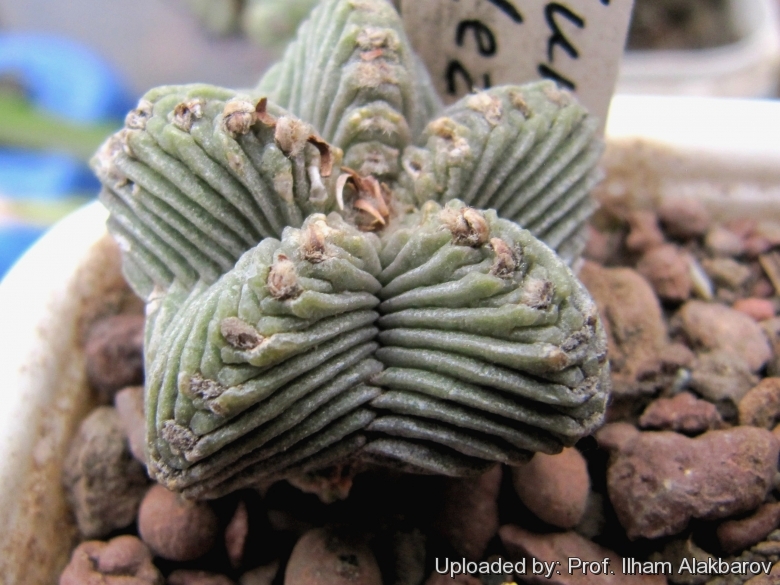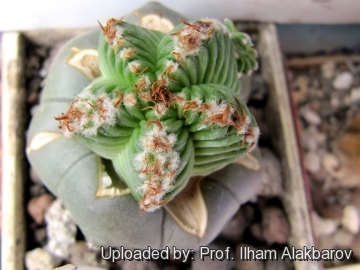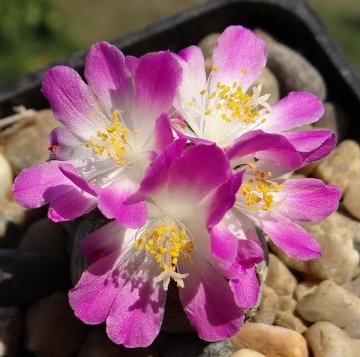




Your support is critical to our success.

Origin and Habitat: Aztekium valdeziiSN|4248]]SN|25623]] is endemic to a small area of about 2 square miles in the Rancho Guadelupe, Nuevo Leon, Mexico (Sierra Madre Oriental).
Habitat and ecology. This species grows in ravines similar to the habitat of
Aztekium ritteriSN|25623]]SN|4248]]. The vegetation consist of a mixture of shrubs and succulents present in the surrounding habitat, among which are: Cordia boissieri, Acacia rigidula, Celtis pallida, Helietta parvifolia, Gochnatia hypoleuca, Guaiacum angustifolium, Caesalpinia mexicana, Agave lechuguillaSN|562]]SN|23013]], Agave striataSN|23013]]SN|562]], Hechtia glomerata, Echinocereus penthalophus, Ferocactus hamatacanthusSN|3403]]SN|3403]], Mammillaria heyderiSN|20805]]SN|20805]]; occuring in close proximity with A. valdezii is only Selaginella lepidophylla. Up to date only few wild specimens are alive, their environment has almost been wiped out by looter. The species is illegal to collect from the wild, the sale of the seeds or living plant is also illegal right now as the only way seeds can be collected is by harvesting in the wild which is illegal.
Synonyms:
- Aztekium valdezii Velazco, Alvarado & S.Arias
Description: Aztekium valdeziiSN|4247]]SN|25623]] is a tiny e cactus species just about 2-6 cm tall in habitat, the plants are star-shaped when viewed from above simple or branched from the base. When blooming, a single nine-petal flower, white in the centre changing to bright magenta on the outside, tops off each plant. Aztekium valdeziiSN|4248]]SN|25623]] is the third species of Aztekium in the family of cacti.
Derivation of specific name: The species name is given in honor of Biol. Mario Alberto Valdéz Marroquín who discovered the plannt in the state of Nuevo Leon in 2012.
Roots: Simple, fibrous, thickening at the boundary with the stem.
Stem: Globose, 1- 6 cm tall, up to 6 cm in diameter, greenish-grey.
Ribs: Mostly 5, margin rounded in cross section, with even and regular horizontal rib-like formations formed by the compressed tubercles from the apex to the base, without secondary inter-ribs (false ribs).
Areoles: Closely set, 1 mm across, covered with yellowish-white hairs only in young areoles.
Spines: 3(-4), abput 6-11 mm long, flattened, papyraceous, curved and twisted toward the apex of the plant, present only in the upper half of the stem.
Flowers: Apical, funnel shaped, 10-19 mm long, 15-25 mm in diameter. Pericarp naked. Outer segments, up to 7 mm in length, up to 2 mm in diameter, elliptical, with acute apex, white in the proximal parts and light or intense magenta in the distal parts. Inner segments up
to 11 mm in length, up to 4 mm in diameter, oblanceolate, with rounded apex, deep pink or magenta, and white only the proximal third. Stamens up to 4 mm long, white, anthers are yellow. Style up to 10 mm long, stigma lobes 4-5.
Blooming season: Late spring and early summer.
Fruit: Rounded, naked, after breaking up with a dehiscent pericarp, irregular with age.
Seeds: 0.37-0.69 mm long,0.42-0.69 mm thick, ovoid, opaque, dark brown.
Related species: Aztekium valdezii is very distinguishable from both Aztekium ritteriSN|25623]]SN|4248]] and Aztekium hintoniiSN|25623]]SN|4247]], in a few aspects, it separates from the first species by having only a maximum of 5 ribs, the lack of inter-ribs (false ribs) between the main ribs and the size and colour of perianth segments; while it differs from A. hintonii in the smaller body size, the maximum number of ribs (up to 10 in A. hintonii) and also the size and colour of perianth segments.
Notes: The genus Aztekium contains three species of small globular cactus. Discovered in 1929 by F. Ritter, in Rayones, Nuevo León, Mexico, this genus was thought to be monotypic (with Aztekium ritteri) until a second species (Aztekium hintoniiSN|4247]]SN|4247]]) was discovered by George S. Hinton, in Galeana, Nuevo León in 1991. A further species, Aztekium valdesii, was discovered in 2011 by M.A. Alvarado Vázquez in the Sierra Madre Oriental mountains of Nuevo León.
Bibliography: Major references and further lectures
1) Dag Panco, “Aztekium valdezii dossier - Interview with Mario Alberto Valdéz Marroquín”, Xerophilia Vol 2, No. 3 (6) –September 2013 online <http://xerophilia.ro/wp-content/uploads/2013/09/Xerophilia-nr-6.pdf.>
2) Leslie Patiño “New Star Aztekium valdezii Endangered?” November 11, 2013
3) Gustavo Mendoza Lemus 09/11/2013 “Hallan nueva cactácea; ya la venden en UE,” in the November 9, Milenio newspaper, Monterrey edition. <http://www.milenio.com/monterrey/Hallan-nueva-cactacea-venden-UE_0_187181310.html>
4) Carlos Gerardo Velazco Macías, Marco Antonio Alvarado Vázquez and Salvador Arias
5) Montes “A new species of Aztekium (Cactaceae) from Nuevo León, México” Xerophilia Special Issue no 2, pages 13-18, August 2013
6) Member of the iNaturalist Network “Genus Aztekium, a member of Cacti (Family Cactaceae)” <http://www.inaturalist.org/taxa/184454-Aztekium> web 03 January 2016

Aztekium valdezii Photo by: Prof. Ilham Alakbarov

Aztekium valdezii Photo by: Agócs György
Cultivation and Propagation: Aztekium are by far the most challenging and difficult cactus to grow, they are of extremely slow growth - probably the slowest of the entire cactus family. They usually take several years for growth to be even noticeable. Once a specimen is established on its own roots it is no trouble to keep it ,and becomes an easy plant to manage.
Water requirements: They need good drainage and regular water in summer. They should be dried out completely for their winter rest when they will withstand temperatures down to to -4°C for short periods.
Light requirements: They prefer some shade.
Propagation: It usually multiplies by seeds. The seeds are extremely fine and germinate readily, but the seed germination rate is very low for everyone (less than 5%). The minute seedlings are very sensitive for the first two months. But many of them perish, and taking them to a viable size is very difficult. The seedling are so small that a drop of water moves them like crazy. They are usually grafted to increase growth speed. In any case, grafting produces rather atypical plants which tend to be more obese and to offset much more readily than plants growing on their own roots. The offsets of grafted plants are often produced from areoles high up on the plant body, rather than at ground level. It is also possible to root the offsets from grafted plants, but with little success.
| Your Actions | |
|---|---|
| Back to Aztekium index | |
| Back to Cactaceae index | |
 |
Back to Cacti Encyclopedia index |
Privacy stantement - Terms and conditions - How to cite - About us - Feedback - Donate



